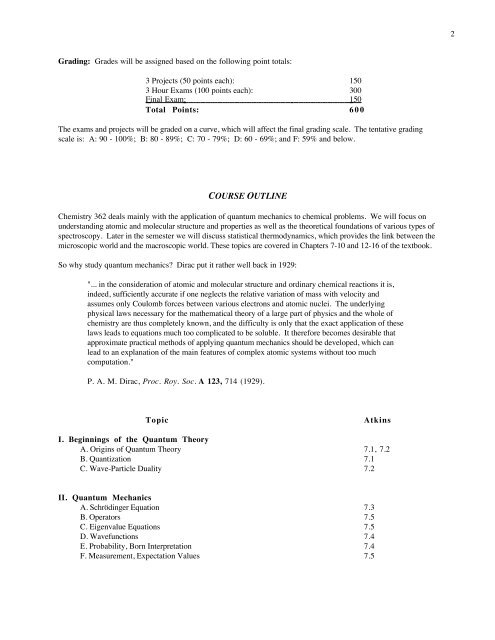Chemistry 362 - Physical Chemistry II Spring 2013 COURSE ...
Chemistry 362 - Physical Chemistry II Spring 2013 COURSE ...
Chemistry 362 - Physical Chemistry II Spring 2013 COURSE ...
Create successful ePaper yourself
Turn your PDF publications into a flip-book with our unique Google optimized e-Paper software.
2Grading: Grades will be assigned based on the following point totals:3 Projects (50 points each): 1503 Hour Exams (100 points each): 300Final Exam: 150Total Points: 600The exams and projects will be graded on a curve, which will affect the final grading scale. The tentative gradingscale is: A: 90 - 100%; B: 80 - 89%; C: 70 - 79%; D: 60 - 69%; and F: 59% and below.<strong>COURSE</strong> OUTLINE<strong>Chemistry</strong> <strong>362</strong> deals mainly with the application of quantum mechanics to chemical problems. We will focus onunderstanding atomic and molecular structure and properties as well as the theoretical foundations of various types ofspectroscopy. Later in the semester we will discuss statistical thermodynamics, which provides the link between themicroscopic world and the macroscopic world. These topics are covered in Chapters 7-10 and 12-16 of the textbook.So why study quantum mechanics? Dirac put it rather well back in 1929:"... in the consideration of atomic and molecular structure and ordinary chemical reactions it is,indeed, sufficiently accurate if one neglects the relative variation of mass with velocity andassumes only Coulomb forces between various electrons and atomic nuclei. The underlyingphysical laws necessary for the mathematical theory of a large part of physics and the whole ofchemistry are thus completely known, and the difficulty is only that the exact application of theselaws leads to equations much too complicated to be soluble. It therefore becomes desirable thatapproximate practical methods of applying quantum mechanics should be developed, which canlead to an explanation of the main features of complex atomic systems without too muchcomputation."P. A. M. Dirac, Proc. Roy. Soc. A 123, 714 (1929).TopicAtkinsI. Beginnings of the Quantum TheoryA. Origins of Quantum Theory 7.1, 7.2B. Quantization 7.1C. Wave-Particle Duality 7.2<strong>II</strong>. Quantum MechanicsA. Schrödinger Equation 7.3B. Operators 7.5C. Eigenvalue Equations 7.5D. Wavefunctions 7.4E. Probability, Born Interpretation 7.4F. Measurement, Expectation Values 7.5

















